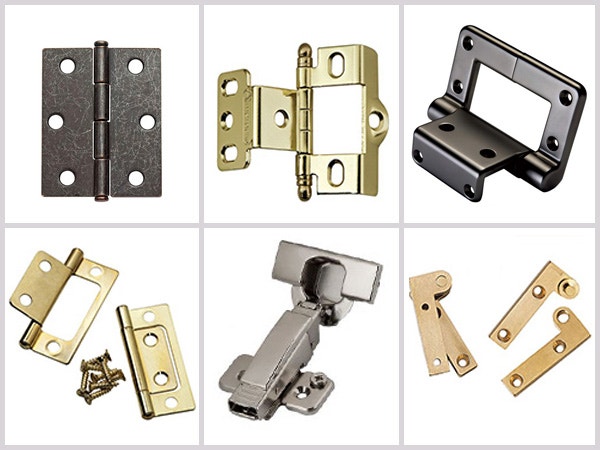Hinge Glossary
What are the different types of hinges and parts of a hinge? This glossary includes all the important terms you need to know related to hinges and hinge installation. Understanding these terms will help you select the best hinge for your project.
Shop Our Selection of Hinges
Ball TipThe exposed decorative tip of a butt hinge, shaped like a ball. |
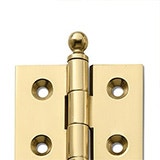 |
Barrel HingesSmall barrel-shaped hinges typically used for small cabinets or jewelry boxes. They are fully concealed when closed, both on the back and front. Installation is relatively easy, requiring only one hole to be drilled for each half of the hinge. |
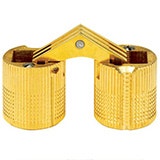 |
Butt HingesThe classic traditional hinge, featuring two flat leaves joined at the knuckle with a single pin. The pin can be fixed or removable, for easy door removal. Intended for full inset applications, and also used on chest lids. Often requires mortising into the door and face frame to achieve the proper gap. However, no-mortise butt hinges are available. These have leaves that nest inside of one another for a minimal gap. Shop All Butt Hinges. |
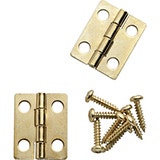 |
Button TipA flat tip on the end of the hinge pin. Also called flat tip. |
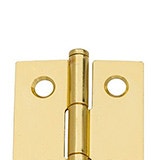 |
Butterfly HingeA type of decorative hinge that is named for its attractive butterfly shape, or ''H'' shape, when installed. Butterfly hinges are surface-mounted on the face of both the cabinet and the door, and can be found for full inset doors and for 3/8'' inset doors. |
 |
Clip-On Hinge''Clip-on'' refers to a feature of European Long Arm Hinges that allows the cabinet door to be quickly mounted to or removed from the cabinet using a toolless ''clip'' that is built into the hinge. |
 |
Compact HingeOne-piece European hinges for face frame cabinets. They are easy to use and are adjustable inside, height, and depth dimensions. They work with a wide range of overlays, but are not available for inset doors, which require Long Arm European hinges. |
 |
CupThis refers to the round body of the door arm on a European hinge, both Compact and Long Arm styles. The cup is inserted in a hole drilled in the door, typically 35mm in diameter. Cup depth is how deep the hole in the door is drilled. For doors with edge profiles, this is a critical dimension to monitor, otherwise the cup hole can break through the edge profile on the front of the door. |
 |
Degree of openingThe angle that a door will open to. Some hinges will allow the doors to open further, allowing for better access to the contents of the cabinet. Others will limit the opening angle to prevent the door from banging into adjacent walls or cabinets. |
 |
Demountable HingesThese hinges mount to the cabinet or door utilizing a slot. This allows the hinge to be easily removed or adjusted as needed. Demountable hinges come in two styles - Single Demountable Hinges use a slot for mounting only in the cabinet, and Double Demountable Hinges use a slot for mounting in both the cabinet and the door. |
 |
Double Wrap-AroundA type of hinge that wraps around both the cabinet facing and the edge of the door. The 90° angle acts like a fence for perfect registration against the back of the face frame. |
European HingesThe benefit of these hinges is their built-in 3-way adjustments. They can be adjusted up and down, side to side, and in and out from the face of the cabinet. This allows total control for aligning the door to the cabinet and to adjacent doors. They are also totally concealed and usually self-closing.Shop All European Hinges. European hinges are available in two configurations. Compact style European hinges are one-piece hinges and are available for face frame cabinets with doors that overlay the face of the cabinet. Long Arm style European hinges have two pieces – a cabinet mounting plate, and a door section, commonly called the arm. Both styles require a hole (typically 35mm) be drilled in the door for the cup, or body of the hinge to be set into. These hinges can be used in a wide range of applications, on both Face Frame or Frameless cabinets. They also are available for inset doors. |
 |
Extruded HingesExtruded hinges are typically brass hinges that are created by forcing molten metal into a die under high pressure. They are thicker, sturdier, and more expensive than stamped hinges. |
Face Frame CabinetFace frame cabinets incorporate a frame (often made from 1-1/2'' to 2'' wide solid wood) that is attached to the front edges, or face, of the case. Hinges mount to this face frame. This is a common style in American cabinets. |
 |
Finial TipThe exposed decorative tip of a butt hinge, shaped like a finial or steeple. |
 |
Frameless CabinetFrameless cabinets are made from just four panels to form a box, plus a back. The exposed front edges of the plywood, MDF or particleboard panels are covered with edgebanding. In this style of cabinets, hinges are mounted to the cabinet interior. Frameless cabinets also are sometimes called Euro or Euro-style cabinets. |
 |
Flat TipA flat tip on the end of the hinge pin. Also called button tip. |  |
Free swingingThis means the hinge can move freely along its path from open to closed. There is no closing assist or catch feature to keep the door shut. These are often made available as an option to identical Self-Closing Hinges so you can use one of each when the self-closing force would otherwise be too abrupt. |
 |
Full OverlayThis term typically only applies to European hinges. A full-overlay door covers all or nearly all the front edge of a Euro-style cabinet. Most often, this means 5/8'', but Euro hinges are adjustable for slightly more or less overlay. See Overlay. |
 |
GapThis term typically only applies to European hinges. It refers to the distance from the back of the door on the hinge side to the front face of the cabinet. A rubber bumper is used on the pull side of the door to make the gap even there. |
 |
Half OverlayThis term is only used for European hinges. Half overlay hinges allow the hinge side of the door to cover half of a 3/4'' partition. Though adjustable, the overlay is typically 5/16'', so that two doors hinging on opposite sides of a 3/4'' partition will have 1/8'' of space between them. Not to be confused with 1/2'' overlay, which refers to Semi-Concealed hinges that cover up the cabinet or face frame by 1/2''. See Overlay. |
 |
InsetFull-inset doors, often called simply ''inset doors,'' fit entirely within the cabinet opening and sit flush with the face of the cabinet sides or face frames when in the closed position. See Overlay. |
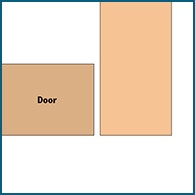 |
3/8'' InsetA type of door that is rabbeted around the edge so it fits partially inside of the cabinet, typically a face frame cabinet. Often called ''lipped'' doors. |
 |
Knife HingesAlso called pivot hinges, knife hinges have two straight or ''L'' shaped leaves that are connected at a pivot point. Typically used for small boxes or cabinets. |
 |
LeafThe two flat halves of a butt hinge that revolve around the pin. One leaf mounts to the cabinet; the other mounts to the door. |
 |
Long Arm HingeThese are two-part European hinges, consisting of the hinge arm and the mounting plate. Sometimes called a ''Clip-On Hinge,'' they have 3-way adjustments (side-to-side, up and down, and in and out), work with a wide range of overlays, and are available for both overlay and inset doors. Rockler offers these hinges in convenient matched bundles that include hinge, mounting plate and mounting hardware. |
 |
Mounting PlateThe cabinet component of a Long Arm European Hinge. The hinge arm clicks onto the mounting plate without tools, allowing easy installation and removal. |
 |
No-Mortise HingeA style of butt hinge with leaves that nest inside themselves when closed. Used in full inset applications, this minimizes the space between the edge of the door and the cabinet, eliminating the need for a mortise. The thickness of the hinge leaf itself (usually around 1/16'') sets the spacing. Since there is no mortise to restrict the hinge, it is usually adjustable via slotted holes. Shop All No-Mortise Hinges. |
 |
No-Mortise Wrap-AroundThis is a No-Mortise hinge that also wraps around the edge of the cabinet or door. The 90° angle allows easy registration off of the back of the face frame, and often offers more screw holes for better strength. |
 |
OverlayOverlay doors overlap the front edge of the cabinet opening by some specified dimension. ''Overlay'' can also refer to the dimension itself, and in this context, can vary widely depending on the style of door, cabinet and hinge. |
 |
Piano HingePiano hinges, also called continuous hinges, are long hinges that offers continuous support along their length. Available in traditional flat leaves or in a wrap-around design to increase mounting strength. Rockler’s piano hinges also include mounting slots, which allow for perfect alignment during installation. Shop All Piano Hinges. |
 |
Pivot HingeSimple hinges that rotate on a single pivot post. Often used on glass door hinges. Also see Knife Hinge. |
 |
RevealOn an overlay door, this is the amount of the cabinet face that is exposed when the door is closed. It extends from the hinge side of the door to the edge of the cabinet wall, or partition. On a full inset door, ''reveal'' sometimes refers to the gap between the door edge and the inside of the cabinet wall. |
 |
Semi-Concealed HingeThis term is applied when some of the hinge shows on the outside of the cabinet, but a portion of it is hidden behind the door. Semi-concealed hinges are used on face frame cabinets with overlay doors, and are available in Face-Mount or Wrap-Around designs. With Semi-concealed hinges, the hinge pin is always visible, and the mounting screws are sometimes visible as well. If the screws are not visible, then the hinge is a wrap-around style, meaning it wraps around and screws to the inside edge of the frame. If the screws are visible, it is a ''face-mount'' hinge. Shop All Semi-Concealed Hinges. |
 |
Snap-CloseThis type of hinge has a design feature, usually a spring, that helps pull the door in and keep it shut when the door is brought within a few inches of being closed. Sometimes referred to as ''self-closing.'' Strictly speaking, however, ''self-closing'' is actually a broader term that can mean either ''snap-close'' or ''soft-close'' (see below). Snap-close hinges close abruptly, while soft-close hinges close slowly. |
Soft-CloseAllows your cabinet door to close smoothly and silently no matter how hard the door is closed. With this feature integrated into the hinge cup, there is no additional hardware to install on the hinge or mounting plate. |
Soss HingesA specific brand of totally concealed hinge. Requires routing a specially shaped oval mortise in both the door edge and face frame. No metal shows when the doors are closed, making them a good choice for glazed doors, or wherever minimal obstruction is needed inside the cabinet. |
 |
Stamped HingesInexpensive hinges that are usually stamped out of thin steel or brass plates. |
 |
Strap HingeA type of decorative hinge that is often used on chests and jewelry boxes. The strap hinge's long length brings to mind the leather straps on old steamer trunks. |
 |
Surface-MountA hinge that can be mounted directly to the door and cabinet without needing to machine a mortise or cup hole. |
 |
TabOn European hinges, this is the distance from the edge of the door to the edge of the cup hole. |
 |
Three-way AdjustabilityThree-way adjustment allows the door to be adjusted up and down, side to side, and in and out from the face of the cabinet. This allows total control for aligning the door to the cabinet and to adjacent doors. |
 |
TipThe end of the hinge pin. The tip can be flat or decorative, and fixed or removable. |
 |
Torsion HingeA combination hinge and lid support that provides constant support for the lid in any position using a unique torsion mechanism in the hinge knuckle. Shop All Torsion Hinges. |
 |
Variable OverlayA hinge that is surface-mounted to the face of the cabinet, and to the back of the door, such that the door can be positioned anywhere on the cabinet face to create the overlay needed. |
 |
Wrap-AroundA style of hinge where one (single wrap-around) or both (double wrap-around) leaves of the hinge Wrap-Around the edge of the door and/or the face frame. |
 |
Zero ProtrusionZero Protrusion refers to a hinge that allows the door to open far enough so that a shelf or drawer inside the cabinet can be pulled out without hitting the door. |
 |
270-Degree HingeA hinge that allows the door to open 270 degrees. This allows the door to open all the way around the cabinet until it is parallel with the cabinet side. |
 |
Shop Our Selection of Hinges
Keep the inspiration coming!
Subscribe to our newsletter for more woodworking tips and tricks
